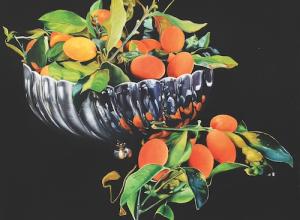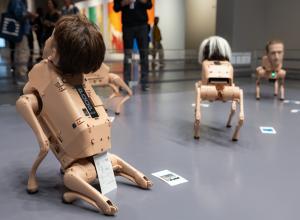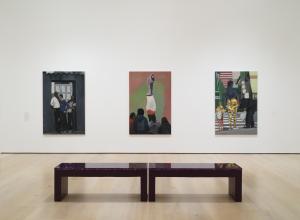
Art Basel Hong Kong 2025.
The 2025 edition of Art Basel Hong Kong featured 240 galleries from 42 countries and territories, showcasing artistic practices demonstrating the show’s commitment to global diversity and regional representation.
Over half of the participating galleries were from the Asia-Pacific region, emphasizing Art Basel’s essential role as a platform for the region’s dynamic art scene. Attracting an impressive attendance of 91,000 visitors during its VIP and public days further underscored Hong Kong’s position as an important cultural center.
“Art Basel Hong Kong 2025 has once again demonstrated the city's role as a global cultural nexus,” Art Basel Hong Kong director Angelle Siyang-Le shared. “This year’s edition not only featured a diverse and innovative program but also underscored our deep commitment to nurturing Asia’s thriving art ecosystem. As we continue to redefine cultural narratives and ignite new creative possibilities, we remain dedicated to supporting the future of the contemporary art scene in Asia.”
Prominent private collectors and art patrons attended from over 70 countries and territories, including Hong Kong, Mainland China, Korea, the United States, the United Kingdom, Australia, Taiwan, Singapore, and the Philippines.
Art & Object surveyed a notable array of artworks displayed across various mediums to select our favorites. Please scroll through the slideshow below to view our picks.

Luc Tuymans, a Belgian figurative painter with a substantial following and an esteemed collection of collectors, creates works that explore how history and mediated imagery have influenced today's world. Rendered with swift brushstrokes of wet paint to produce a blurred, dreamlike effect reminiscent of distant memories, his works often incorporate appropriated images from iconic photographs and films. Marking his first visit to China in 2003, Morning Sun captures the new skyline of Shanghai, based on a photograph the artist found in the Financial Times. A symbol of contemporary China, the architecture of the latest buildings evokes a futuristic vision rising above the river.
Image: Luc Tuymans, Morning Sun, 2003. Oil on canvas, 61 2/5 × 70 4/5 in / 156 x 180 cm.

By exploring narrative themes of innocence, humor, and eroticism, John Currin employs classical painterly techniques to portray highly charged social and sexual subjects through realistic painting. Drawing inspiration from Old Master portraits, pinups, pornography, and the kind of narrative realism associated with Norman Rockwell, his figurative paintings and drawings blend beauty with the grotesque and a touch of surrealism. Skillfully borrowing from high and low culture found in museums and media, canvases like New Girl combine the painted likeness of a youthful beauty from an earlier era with a more modern fashion magazine pose.
Image: John Currin, New Girl, 2025. Oil on canvas, 28 x 24 in / 71.3 x 61 cm.

A painter and sculptor of whimsical figures and forms, Masako Miki playfully explores both abstraction and figuration in her cleverly crafted sculptures and colorful ink and watercolor works on paper. Born in Osaka and based in Berkeley, she draws inspiration from ancient Japanese mythology and folklore for her Shinto-inspired artworks. Her Benevolent Observer—crafted from XPS foam intended for attic insulation, encased in wool, and supported like a stool or a three-legged creature (notice the little hand)—connects to the vibrant shapeshifting works that the artist will showcase in a solo exhibition at ICA San Francisco in May.
Image: Masako Miki, Benevolent Observer, 2025. Wool on XPS foam and wedge wood, 21 × 13 × 10 in / 53.3 × 33 × 25.4 cm.

Involved in counterculture movements during the 1960s, which fostered a commitment to social change and raised questions about identity, power, and transformation, Ann Leda Shapiro creates work that explores the body and its relationship with the environment. A feminist in the 1970s and a Guerrilla Girl in the 1980s, she later studied acupuncture and holistic medicine, which informs the cycles of renewal and interconnectedness explored in her emblematic paintings and watercolors. With a solo show at the gallery, her Stability watercolor guided the fair’s audience on a spiritual journey, linking thousands of marks to form a resilient tree of life, steadfastly standing.
Image: Ann Leda Shapiro, Stability, 2023. Watercolor on paper 30 x 22 in / 76 x 56 cm.

Celebrated for her visual analysis of women's representation and gender construction in portraiture, advertising, folklore, social media, and film, Robin F. Williams injects humor and insight into her pulsating portrayals of psychological subjects. Continually experimenting with different ways of applying and manipulating paint, Williams presents graphically sophisticated scenes that speak to our times. Accordingly, her Siri Recharging painting depicts Apple’s digital assistant relaxing on a beach while recharging her energy, serving as a surrogate for the Brooklyn-based painter or any artist in search of renewed inspiration. Arrestingly painted with soft feathered forms and vivacious hues, the painting shapes the enigmatic voice while capturing the character’s aura.
Image: Robin F. Williams, Siri Recharging, 2025. Oil on canvas, 48 × 48 in / 121.9 × 121.9 cm.

Presenting a form of ceramic sculpture rarely seen outside of Japan, Masaomi Yasunaga uses glaze rather than clay as his primary building material. Coil built on a handwheel, the glaze is combined with raw materials such as rocks, rock-forming minerals, metal, and glass powders and then buried in layers of sand or kaolin (a soft white clay) for firing in the kiln. Once removed from the kiln, his primordial sculptural forms are excavated from their beds like archeological finds. Rebelling against this homeland’s more traditional ceramic techniques, he carries on the experimentation of his avant-garde mentor, Satoru Hoshino, a celebrated member of the post-war Sōdeisha ceramics school, through sublime yet whimsical works like Fused vessels.
Image: Masaomi Yasunaga, Fused vessels, 2021. Glaze, colored glaze, colored slip, underglaze color, kaolin, 31 9/10 × 23 1/5 × 9 2/5 in / 81 × 59 × 24 cm.

Taking the phenomenon of developing visual fatigue from spending too much time surfing the internet as the point of departure for her vibrant abstract paintings, Korean painter Hejum Bä reflects on our emotional engagements with smartphones through color and the act of navigating the digital world with repeated touches in her gestural brushwork. The Seoul-based artist aims to make sense of the overwhelming imagery in contemporary life by mapping the circuitous flow of actions and images with irregular forms and overlapping colors. Observing people’s interaction with their phones in public, she creates paintings like Haptic Circuitry II, transforming the swiping and tapping gestures into movements of color to convey a world beyond the screen.
Image: Hejum Bä, Haptic Circuitry II, 2024-2025. Oil on canvas, 53 3/10 × 44 1/5 × 1 1/2 in / 135.5 × 112.2 × 3.8 cm.

Approaching her compositions as stills within a broader narrative, Lyn Liu employs a cinematic style emphasizing light, staging, and costume elements. This voyeuristic instinct—a desire to observe without being observed—serves as both a visual strategy and a glimpse into the Beijing-born artist’s childhood experiences as she navigated between cultures, often feeling like a perpetual outsider. Through painting and printmaking, she explores her experiences of alienation, using symbolism and an atmosphere of the absurd to provoke reflections on what the New York-based artist perceives as our oppressive social reality. Her realistic painting, Acupuncture, depicts a close-up of a young Caucasian woman undergoing the traditional Chinese healing procedure, symbolically merging East and West in a transformative way.
Image: Lyn Liu, Acupuncture, 2025. Oil on panel, 20 × 16 in / 50.8 × 40.6 cm.

Described as states of mind rather than mere reflections of reality, Jules De Balincourt’s paintings are imbued with mystery, ambiguity, and psychological depth. Instead of using preparatory sketches, the Paris-born artist, based in Brooklyn and Costa Rica, discovers his paintings while creating them directly on the canvas. Employing bold, bright colors, he continuously examines the discordant and harmonious dynamics between humanity and the natural world. Mysterious personages and uncanny figurations populate his dreamscapes and mirage scenes, as seen in Land Escape. Spectral bodies and silhouettes dance through these unknown realms steeped in radiant colors, where movement and form are freed from ideology.
Image: Jules de Balincourt, Land Escape, 2024. Oil and oil stick on panel, 70 × 80 in / 177.8 × 203.2 cm.
Paul Laster
Paul Laster is a writer, editor, curator, advisor, artist, and lecturer. New York Desk Editor for ArtAsiaPacific, Laster is also a Contributing Editor at Raw Vision and Whitehot Magazine of Contemporary Art and a contributing writer for Art & Object, Galerie, Artforum, Artsy, Ocula, Family Style, Sculpture, and Conceptual Fine Arts. Formerly the Founding Editor of Artkrush, he began The Daily Beast’s art section and was Art Editor at Russell Simmons’ OneWorld Magazine. Laster has also been a Curatorial Advisor for Intersect Art & Design and Unique Design, as well as an Adjunct Curator at P.S.1 Contemporary Art Center, now MoMA PS1.























